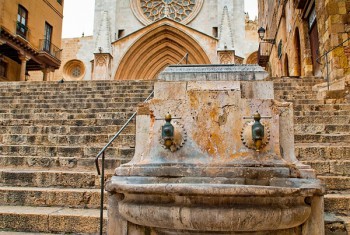
Tarragona (Roman Taracka, Adv. Tarragona) is a beautiful ancient Spanish city located on the Mediterranean sea, 100 km southwest of Barcelona. The regional centre, the second after the capital city of Catalonia province, at any hour uncrowded and peaceful. Here you can find a lot of sights, beautiful harbour and sandy beaches and excellent conditions for recreation.
The most impressive fact, without any doubt, is that Tarragona is an open air Museum of ancient Roman culture with many well preserved buildings. That is why the Roman monuments of Tarragona belong to the Treasury of world history and listed as a world heritage site by UNESCO.
City "Tarraco" ("Tarraco") was one of the most important metropolises of the Roman province of Hispania. Exceptional values Tarragona achieved thanks to the Roman Emperor Augustus. Conspiracies and numerous local wars, constant political infighting and mysterious events – has seen a lot of Tarragona on the way of transformation from a small military camp in the brilliant capital of the Roman Empire in Spain. During the four centuries the Romans stay, Tarragona survived the lush flowering of culture, economy, architecture: the city was the residence of the emperors Julius Caesar, Augustus, Marcus Aurelius was born here, lived Seneca. And, fortunately, much of this glory has been preserved until today. In the vicinity of the city still you can see a large number of historical monuments of the reign of the great Roman Empire.
The old city of Tarragona is surrounded by Roman walls (Murallas de Tarragona ), built in the 3rd century BC, reaching in the length four kilometres. Later parts had been modified or destroyed. However, there is a kilometer of the original wall height of 12 meters, as well as the original gates and three towers.
The Santa Maria Cathedral (Catedral de Santa Maria) – this is the most famous and amazing place of historical centre of Tarragona, belonging to the middle Ages. The Cathedral of Santa Maria is not only the main temple of the city, but also the largest Cathedral in the whole of Catalonia. The base of the Cathedral is a Latin cross with size 104 54 meters. The architecture of the Church combines elements of two styles: Gothic and Romanesque.
The ancient Roman Forum consists of two large squares, surrounded by columns and arcades. In the square, which is located above, is the Cathedral, built in Gothic style, on the spot where the original was built a huge Roman temple. Passing the stairs, you can reach the lower square, which was once the largest in the entire Roman Empire, with a length of 318 meters and a width of 175 meters.
Also, in more recent times, nearby, was built the Roman Theatre, however, today we can see only a small, surviving part.
Another amazing historical place - the amphitheater of Tarraco, which is located outside the city walls, near the sea, for the most part extant. And it seems like just yesterday it was filled with a crowd of local plebs to look at the gladiators. Within this complex you will also find the ruins of an unknown building with finishing the Basilica in the Gothic style, as well as the old Roman Church.
Interesting is to visit the legendary Roman aqueduct "the Aqueduct Ferreres" (Acueducto de les Ferreres), or Devil's Bridge, built in the I century BC, take a walk. This building is located 4 kilometres from Tarragona and has impressive dimensions: 27 meters high and 217 meters. According to the legend, the bridge was built for the devil in exchange for the soul of a donkey. In fact, it's not a bridge over a vast valley, and the aqueduct that supplied water to the city from the river Francolí to the 18th century.
6 km from Tarragona, near the street of vía Augusta is the Torre de Los Escipiones (Tower of Scipio) and is a Roman funerary monument, built in honor of the brothers Scipio. The tower is 9 meters high was built in the I century BC, it has three tiers, the upper of which had a pyramid, partially ruined. The middle tier has two statues dedicated to the Oriental deity Attis. Via Augusta is notable because it crosses the whole Iberian Peninsula, beginning in Perinea and ending in Cadiz.
In Tarragona there are many beautiful monuments and a later time. So, the city's main streets — Rambla (Rambla) and Nova Rambla (Rambla Nova) — decorate the buildings, built in the late XIX — early XX centuries art Nouveau, Baroque and Neoclassicism.
After the Grand lessons of history, you can relax on one of the most amazing and famous terraces of Tarragona with the speaker called the Mediterranean Balcony (Balcón del Mediterráneo), enjoying magnificent views of the sea, the port, the beach and the amphitheatre.
And if the time in Tarragona and so flows more slowly than elsewhere, at such moments, it just stopped.
The coastline of Tarragona lies within 15 kilometers. All the beaches are wide, sandy, fine Golden sand and its long sloping entrance to the sea; ideal for families with children. The beaches in Tarragona are located in small coves. Most of the beaches awarded the prestigious Blue flag.
In Tarragona has an extensive network of various urban and family hotels, guest houses, hostels and apartments. But particularly noteworthy are the campsites on the Mediterranean coast: for a relatively small fee, you will receive and the place in Tarragona's sun, and well-maintained parks, and entertainment for every taste, age and budget.
The nearest international airports is in the city of Reus (15 km) and Barcelona (100 km).